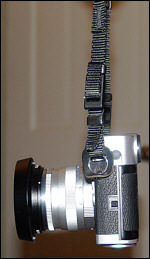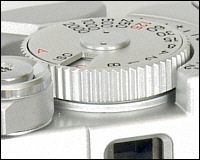 |
|
 |
||||||
|
|
|
|
|
|
|
|
||
 More
on ergonomics:
11/13/2005
More
on ergonomics:
11/13/2005
The eyelets for the neck strap are on the sides of the camera, but toward the front. Seems an unusual place, but here's something else unusual. When a lens is mounted, you can hold the camera by the strap and the camera doesn't tip forward or backward. What this means is that the camera with lens is almost perfectly balanced. That was true with either the 25mm or 50mm mounted on the camera. That was unexpected and impressive.
 A well-balanced camera. I'm using a Domke Gripper. The Zeiss Ikon strap is still in the box. I love the Domke Grippers. |
This camera is very solid. No flexing. No creaks. No rattles. I can see myself using this camera a lot in the next six months or so.
Eye placement is very important. Moving your eye to the left or right slightly will cause the secondary image in the rangefinder patch to fade. It doesn't disappear entirely, but it does fade. This hasn't been a problem for horizontals. For vertical shots, however, I've sometimes had to hunt for the rangefinder patch. I hope this is something that will be easier as I become more familiar with the camera.
The rewind crank is a bit small for my liking. But I think they're all a bit small. The last one I really liked was on a Konica III. I sometimes can't grab the tip of the Zeiss Ikon's crank the first time. I'm glad that it has a directional arrow on the cap of the crank, because I almost rewound in the wrong direction after completing my first roll. You spend so much time rewinding in a clockwise direction that you want to do the same thing with this camera.
 Vertical design of the serrated edge of the shutter speed dial make it difficult to change film speeds. Not impossible, just difficult. |
The shutter speed dial has one shortcoming: It's difficult to grip the dial to lift and turn to change film speeds because the serrated edges are vertical. The reason it's difficult is that there isn't much room for finger movement (see photo).
A diagonal pattern would work and a diamond pattern might even be better. The vertical pattern doesn't permit enough grip, and you need a firm grip because the dial is tightly sprung.
Too much rain today and other chores. No chance to shoot. Darn. Must try again tomorrow. Should go to bed and stop messing with the site.